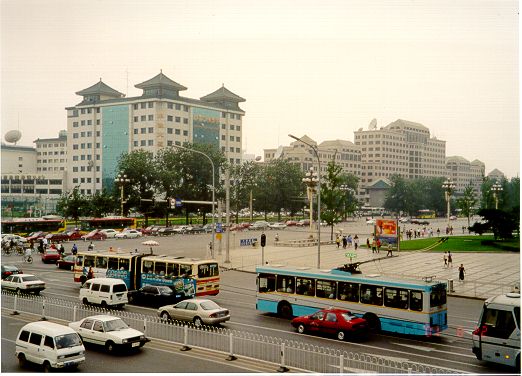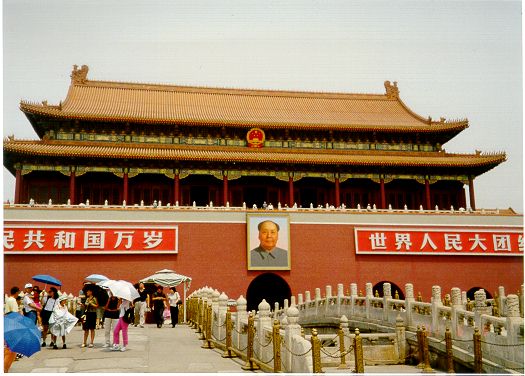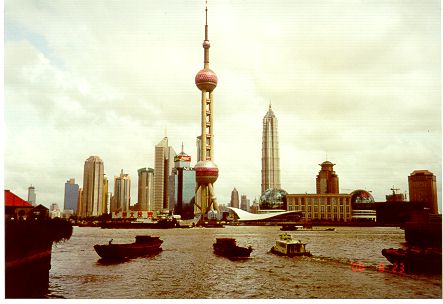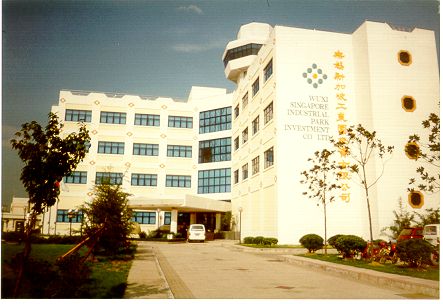Gender, Households and Identity in British and
Singaporean Migration to China
OVERVIEW OF MIGRATION PATTERNS
Migration flows and the make-up of these flows of
highly-skilled migrants varies greatly from region to region
in China. Because of this, each of the main destinations of
British and Singaporean migration will be discussed in turn.
Interviews were carried out in all locations as part of the
research work 1997-2001.
British & Singaporean Migration to China
Obtaining accurate figures regarding the number of Britons
and Singaporeans in China is very difficult for a number of
reasons:
- Highly transitory populations
- Exit data from Singapore and China cannot be adequately
deconstructed
- Despite requirements to register with embassies, not all
immigrants to so
- Chinese data not sufficiently detailed
Because of these problems, we have relied on estimates from
key individuals who have been in China for many years. These
include diplomats, representatives of Chambers of Commerce,
Singapore Club committee members and committee members of
expatriate organisations such as Brits Abroad in Shanghai.
From these individuals, we have concluded that in the five
regions in which we have worked there are about 25,300-27,400 Britons
and 15,000 Singaporeans (see Table 1).
Table 1: Estimates of British and Singaporean
Populations in Study Areas
| |
Britons |
Singaporeans |
|
Beijing |
4000-5000 |
3000 |
|
Guangzhou |
200-300 |
150-200 |
|
Hong Kong |
16,000 |
10,000 |
|
Shanghai |
5,000-6,000 |
1,500 |
|
Suzhou & Wuxi |
<100 |
450 |
British Business in China
While Britons and Singaporeans obviously work for a range
of companies and organisations with different national bases,
Table 2 provides a useful overview of the distribution of
‘British’ businesses in China by sector and location. These
regional trends are picked up later.
Table 2: Distribution of British Business in
China by Sector and Location, 2000
|
Sector |
Beijing (N=109) |
Guangdong (N=41) |
Hong Kong
(N=272) |
Shanghai (N=173) |
| |
% |
% |
% |
% |
|
Accountancy |
7.3 |
2.4 |
2.6 |
2.9 |
|
Architecture |
1.8 |
- |
3.7 |
2.3 |
|
Aviation/ Aerospace |
4.6 |
2.4 |
1.1 |
1.2 |
|
Banking |
8.3 |
4.9 |
8.1 |
9.2 |
|
Business Services |
0.9 |
- |
4.8 |
4.6 |
|
Chemical/Petroleum |
2.8 |
9.8 |
1.5 |
2.9 |
|
Conglomerate |
1.8 |
- |
1.1 |
1.2 |
|
Computing |
2.8 |
- |
1.5 |
- |
|
Construction |
- |
7.3 |
6.6 |
4.6 |
|
Consultancy |
14.7 |
4.9 |
11.0 |
15.6 |
|
Consumer Products |
2.8 |
7.3 |
1.5 |
1.7 |
|
Distribution |
- |
- |
0.3 |
- |
|
Education |
3.7 |
2.4 |
2.2 |
2.9 |
|
Electronics |
0.9 |
4.9 |
1.5 |
0.6 |
|
Energy |
4.6 |
2.4 |
0.7 |
- |
|
Engineering |
3.7 |
- |
3.7 |
4.0 |
|
Environmental Services |
0.9 |
- |
0.7 |
1.7 |
|
Freight/ Shipping |
3.7 |
7.3 |
4.0 |
5.8 |
|
Hospitality |
1.8 |
2.4 |
4.0 |
2.9 |
|
Industrial/ Manufacturing |
4.6 |
4.9 |
1.8 |
7.5 |
|
Insurance |
4.5 |
7.3 |
5.1 |
3.5 |
|
Legal |
5.5 |
7.3 |
10.3 |
8.7 |
|
Media/PR/Advertising |
2.8 |
2.4 |
3.3 |
1.7 |
|
Medical |
0.9 |
- |
1.5 |
0.6 |
|
Metals/Minerals |
1.8 |
- |
0.7 |
0.6 |
|
Pharmaceuticals |
3.7 |
- |
1.1 |
1.7 |
|
Property |
4.9 |
2.4 |
5.5 |
6.9 |
|
Publishing |
- |
- |
1.8 |
- |
|
Retail/ Wholesaling |
- |
- |
2.2 |
1.7 |
|
Security |
- |
2.4 |
1.5 |
- |
|
Telecommunications |
2.8 |
4.9 |
1.5 |
1.7 |
|
Trading |
0.9 |
12.2 |
1.8 |
- |
|
Transportation |
- |
- |
1.1 |
4.0 |
|
Travel |
0.9 |
- |
- |
- |
Source: Calculated from British Business in China 2000:
Directory of British Chambers of Commerce in China Hong
Kong: EFP International.
Beijing

Dongchang’an Jie,
Beijing
As the capital, Beijing is obviously the primary location
for Singapore and British government representatives. In
addition, many companies have their China representative
offices in Beijing, particularly those companies working in
the service sector. As the service sector expands in China,
changes in legislation and beginning to provide opportunities
for foreign companies to set up businesses in personal
financial services for example. Consultancy companies are also
well represented among British businesses in China.
As well as the diplomatic employees and those working for
large multi-national companies, Beijing also has a significant
population of Britons who are studying Chinese or teaching
English in the Chinese capital.

Tian’anmen Gate,
Beijing
Shanghai

Pearl TV Tower,
Pudong
Shanghai has been a focus for the opening up of China to
external trade, just as it was in the early 20th
Century.
Suzhou & Wuxi

Wuxi Industrial Park
These locations in the Yangtze Delta Region, are key sites
of Singaporean investment in China, including the
government-to-government industrial park in Suzhou and a
private-sector park in Wuxi.
Guangzhou

Downtown Guangzhou
As part of the opening-up to foreign investment, as in Shanghai, Guangzhou has experienced a rapid
growth in overseas investment, particularly within manufacturing sectors. This is linked both to investment
within the city itself, but also in the neighbouring Shenzhen Special Economic Zone. The proximity
of Hong Kong has also encouraged foreign investment and associated migration.
Hong Kong

HongKong Island from
Victoria Peak
Hong Kong has historically been a key trade hub for economic
activities in East Asia. During the British colonial period, it became a regional centre for many transnational coporations
who were looking to expand their activities in the region. This position has continued, albeit with greater competition from other locations, since 1997 when Hong Kong became a Special Administrative
Region within the People's Republic of China.
Gender and Marital Status
Within the migration flows a number of expected trends emerged in relation to gender differences, for both British and Singaporean migrants:
- Men are more likely to be posted overseas than women
- Women posted overseas are almost always single
- Accompanying spouses/partners are almost always women
These trends reflect both the jobs (sector and
level) of those posted to China, and also the social
expectations of migrants regarding households
responsibilities. The companies involved in overseas
postings are often in very male-dominated sectors
(diplomatic service, finance, engineering, chemicals,
ship-building) so a male-dominated skilled labour
flow is not unexpected. In some cases, the
identification of China as a ‘hardship posting’ and
the ability of women to cope with such conditions may
have influenced personnel decisions. However, there
were also a number of cases of companies who preferred women employees because they are less likely to get
involved in romantic liaisons with locals, and are perceived as good
in marketing and customer relations work.
Women posted overseas are invariably single, whereas men’s
postings are less correlated with marital status. For women, being
single means a greater ability to decide on mobility, whereas once
married, or in a long-term partnership, this mobility is reduced
(or is perceived to be reduced) as male partners are higher earners,
women have responsibility for childcare and other domestic tasks, or
power relations within the household mean women have less of a say
in migration decisions.
Routes into Expatriate Work Life
The routes into professional/managerial positions were not a simple case of being posted overseas as anticipated in the research proposal. In fact there were four main routes into employment:
- a.‘Lifetime expatriates’ who have been posted to various parts of the world by TNCs, or who have stayed in the Asian region in a particular sector (such as hotels). Families have usually accompanied them on these postings.
- b.Spouses accompanying ‘lifetime expatriates’ who have found employment on arrival in China.
- c.Younger single professional, or married couple who have taken the opportunity for a one-off posting to China, or have taken up an ‘expatriate’ local contract.
- d.Young single migrants who have travelled to China on holiday or for a temporary teaching post, and have used networks among the expatriate community to find permanent white-collar employment.
All four routes were found among British migrants, but
in comparison Singapore migrants are more likely to be in the third
category of one-off migrants. They are less likely to be found among
‘career expatriates’ because of the more recent entry of Singaporean
companies into regional activities, but also because of greater
concerns about children’s education and the need to remain linked to
Singapore. Singaporeans are also very rarely found in the
‘traveller-turned-worker’ category (d), reflecting economic and
social norms in Singapore. Graduates are encouraged to enter the
labour force on graduation, rather than travel and ‘roughing it’ is
also much less popular in Singapore, where higher levels of comfort
are the norm.
The number of ‘traveller-turned-worker’ individuals among Britons was expected
in Hong Kong where, until 1997, Britons could work without a work
visa, but the number of Britons taking the ‘casual’ route to
employment on the mainland is somewhat surprising. This is indicative
of the greater freedom foreign nationals have had since the start of
the reform process.
Regional Diffferences
Experiences of migration are clearly filtered through the
characteristics of ‘home’, the migrants, and the ‘host society’, and
throughout this research it has been very clear that while there are
some common experiences regardless of location in China, there are
importance differences between the five study areas. These
differences reflect the nature of the local economy and the recent
political history. Main differences are:
- Great sense of isolation for non-working women in Guangzhou, Suzhou & Wuxi because of lack of paid work opportunities.
- Sense of ‘British’ identity heightened in Hong Kong, especially pre-1997, because of colonial relationship.
- Highly-disparate expatriate groups in Beijing, reflecting longer history of expatriate postings to the city.
- Greater mixing between different nationalities (and to some degree with locals) in Guangzhou, because of smaller size of expatriate group.
- · Particular form of ‘community’ construction and national identity formation for Singaporeans in Suzhou because of government-to-government industrial park.
This webpage is maintained by Dr Katie Willis, Department
of Geography, Royal Holloway, University of London,
Egham, Surrey TW20 0EX
Email: Katie.Willis@rhul.ac.uk
HOME |